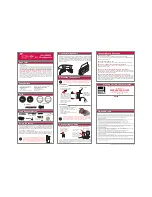
each layer in half lengthwise and you are ready to send the fiber back through the carder.
Second Round
You will now be feeding the fiber through the feeding chute, in the "normal" way. But don't
completely rule out the possibility of feeding from the top again - some fibers card better from
the top, while some do better from the bottom (the chute). Try both techniques and see what
you think. Remember to keep the layers thin, and take the time to pull apart any sections of the divided
batt that seem to be too thick. A second invested here can make a big difference in how
thoroughly your machine cards. Slide a narrow edge of the fiber layer under the licker-in until you feel
the machine begin to draw it in. Now you need to retard the fiber's progress slightly, to keep it from
being drawn in too rapidly. But don't hold it back too firmly, or the fiber will wrap around the licker-in
(the little, feeding drum) instead of being transferred to the swift (the big, carding drum). To get an idea
of how much to hold the fiber back, just do it wrong a couple of times. Then you'll know exactly what
is required. Some people lay a hand lightly on top of the fiber layer in the chute, but I like to give each
layer a series of quick, light tugs, which both slow the progress and thin out the layer being drawn in.
Both methods work.
Fiber on the licker-in
Even when you are feeding the fiber correctly, some will stay on the licker-in. Curiously, it will
probably load to a certain level and then stay there for a long time. If you conscientiously
clean it out, it will quickly reload again to that point. So don't spend more time than is really
necessary keeping it free from fiber. In any case, unless you have already carded the fiber several times,
the stuff on the licker-in will be real junk, dirt, second cuts, and other uglies. Don't be frugal. Pitch it.
Cleaning a drum
carder
This job is even more bothersome than cleaning hand carders, because it takes longer and is
more frustrating. Of course, you can leave bits of fluff embedded in the teeth, especially if you
always process fibers of similar color and texture. But I advise against this, especially if you
have been working on protein fibers-which attract wool moth larvae and carpet beetles.
These pests can be transferred in turn to everything you run through the machine.
You might as well clean your carder, starting with the licker-in, because it's hard to clean that
part without transferring a bunch of stuff onto the swift. Remove the junk batt from the licker-
in as you would a regular batt, while doing your best to keep the swift from taking it. Get most
of the trash off, but don't bother to get it all - you will have to clean this part again at least
once. Now clear the swift of clumps or wisps of fiber by lifting them off with the doffer. There
probably will not be enough residue to form a complete layer, but keep sliding the rod deep
into the teeth so you can remove as much as possible. Keep pulling the fibers out of the teeth
with your free hand - the third one, which is not turning the handle. Or you could use a flicker-
like drum rake, sometimes supplied with the carder or available for separate purchase. If
there is any noticeable amount of fiber in the teeth, however, the doffer is probably the fastest
at this point.
Now look at the licker-in. What did I tell you? Ignore it for now, until the swift is cleaner.
The rake works well at this point for combing through the teeth and lifting out stray bits of
fiber. Always comb with the grain of the teeth, and go as deeply into them as you can. Pull
the bits of fiber out of the rake as you retrieve them, so they don't get redeposited.
When the swift is fairly clean, go back to the licker-in; then repeat your efforts on the swift,
and so forth. A drum carder is a bed that never stays made, but eventually it will be quite
clean. And the whole mop-up operation will take only three or four minutes in all.
If you want the card clothing really clean - for example, if you are changing colors - there is

























